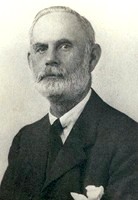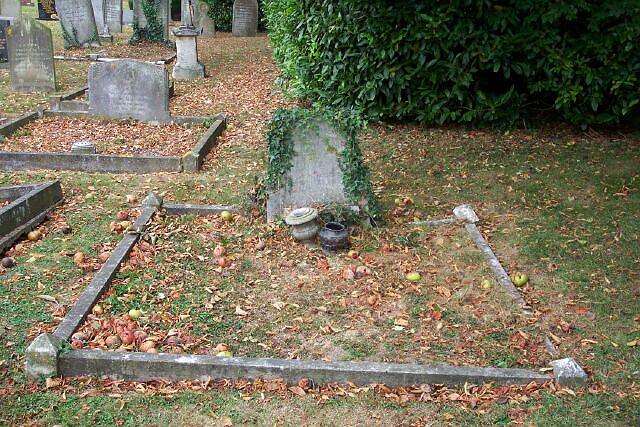|
John
Thomas
Swift
1855-1939 |
 |
J T Swift is best remembered today by his book about the town and locality written during the early part of the 20th century,
although few copies survive outside the reference sections of the public libraries in this part of Lincolnshire.
The life and times of the great and the good are usually recorded in detail when they die with an obituary in the columns of the local press but for some strange reason, this immortality passed Swift by. When his wife Henrietta died in 1921, she received suitable recognition because her public life had been equally prominent, yet 18 years later, his death and funeral were not reported by those newspapers that circulated in Bourne during those years and not one word of his passing can be found in print. I therefore assume that as he died in his 84th year, there was no one close enough, family or friends, to pass this occurrence on in order that his life and the contribution that he made to the town could be given adequate space. The task of writing this profile has therefore been all the more difficult but I hope that I have gone some way towards redressing the balance.
John Thomas Swift was born at Bourne in 1855, the son of William Peck Swift, a
grocer and draper, of Church Street [now Abbey Road], and his wife
Caroline, who already had six daughters, Emily, Sophia, Rosamond, Selina,
Mary and Caroline, and a son, Charles. He was educated locally and became a stalwart supporter of the Baptist Chapel in West Street,
and in 1880, he married a woman five years older than himself, Henrietta Mary Story, born 17th April 1850, daughter of Mr Joseph Story, an ironmonger with business premises in North Street, Bourne. To mark the marriage the couple were presented with a handsome black marble clock by the teachers of scholars of the Sunday School at the chapel with which they were both so closely associated.
By this time, Swift was so well known in the town that the gift was put on public display for a time in the shop window of Mr Thomas Pearce, the watch and clock maker, in North Street. He became a justice of the peace, sitting on the Bourne bench of magistrates, and a member of Bourne Urban District Council and served as chairman from 1908-09. By 1913, he was chairman of the Bourne Urban District sub-committee of the Kesteven Local Pension Committee, the official body that determined claims for entitlement to the old age pension that had only been introduced by Act of Parliament in 1908.
He also became a member of Kesteven County Council, one of the three county authorities responsible for local government administration in Lincolnshire prior to the local government
re-organisation of 1974, and was subsequently elevated to the aldermancy. The ancient title of alderman was still then being used by municipal authorities [until 1972] and bestowed on those senior members of the borough or county councils in England who had been selected by fellow councillors for their valuable service to the community and whose wisdom and advice carried respect.
Youth and education were among his main interests and he
served as a manager of the council or board school [now the Abbey CE
Primary School], chairman of the governors of Bourne Grammar School and as
chairman of the Juvenile Advisory Committee, a local organisation
dedicated to finding employment for young people.
Swift's hobby was local history and he was the author of a book on the town, a modest work published in 1925, entitled Bourne and People associated with Bourne,
although this owes much to an earlier publication Historic Bourne by J J Davies, published in 1909. It contains evidence of his Baptist faith because he gives greater prominence to the chapel in West Street than many other worthy institutions in the town and there is also a curious entry regarding one William Bampton, a member of the church who went to India as a missionary, learned the language, dressed in native costume and visited the bazaars to tell the people the story of Christianity, but the perils of his hard work and the unhealthy conditions cost him his life, although Swift gives no dates for this most interesting tale.
He used the research he had carried out for
the book to give lectures to a wide variety of local organisations and, in those days before radio and television, was in great demand, and he soon became well known in the town, not only as an administrator through his council work, but also as an historian with an apparently intimate knowledge of Bourne's past.
A typical example of his talks is that which he gave in the church on
Monday 19th March 1923 and the Stamford Mercury reported afterwards
that he delivered "a further instalment in his series of interesting
records of Bourne under the title Recollections of Bourne church tower and
the Rev Glyn Morgan presided over a very good attendance".
Swift
was also responsible for the detailed research into the list of past
abbots and vicars of Bourne, from the 12th century to the present day,
that appeared in the first definitive history of the Abbey Church compiled
by C Pask Matthews, headmaster of Bourne Grammar School in 1930, and is
still the standard reference today. His reputation
on historical subjects was respected and he was frequently called on to give his expert opinion.
One notable occasion occurred during a meeting of ratepayers in the Town Hall on Thursday 3rd November 1921 that had been called to sanction the purchase of the market rights from the Lord of the Manor, the Marquess of Exeter, by Bourne Urban District Council, for £50. The main opponents to the transaction were members of the Moisey family who had collected the rents for many years but their claim to have held the market rights for more than three centuries was disputed. Alderman Swift was called in to give his opinion and he told the meeting that he had searched the church records but there was no such name as Moisey registered in Bourne 300 years ago.
The Swifts had been married for 41 years when Mrs Swift died on 13th April 1921 at the age of 70. She had been in failing health for some time but her death was a blow to many organisations because, like her husband, she played an important part in public affairs. Though unsuccessful, she stood for election to Bourne Rural District Council but had the honour of being one of the first two ladies co-opted as trustees to the Board of Guardians whose main task was the administration of the workhouse at St Peter's Hospital, a position she held until her death. She had also been a member of the committee that administered the Butterfield Hospital from its opening in 1910 and for several years
helped oversee that day to day running of its affairs. When the National Health Service Insurance Committee was established she was elected
the Bourne representative for Kesteven and remained a member until her death. Like her husband, Mrs Swift was a staunch supporter of Liberal principles and played a prominent part in the work of the Women's Liberal Association. Religion was also an important part of her life and for some time she was closely associated with the Baptist denomination but in later years switched her support to the Congregational Church in Bourne.
Mrs Swift was so respected in the town that tributes were paid to her work after her death by the various organisations with which she had been connected and even by members of Bourne Urban District Council at their next meeting. The
Stamford Mercury recorded her passing in these words: "Amidst many manifestations of regret, the funeral took place on Saturday afternoon at the cemetery. On route, the blinds of residences were drawn and business establishments temporarily closed. The coffin was deposited in a grave beautifully decorated, chiefly with ivy and daffodils. Numerous floral tributes were placed on the grave, including one from the matron and officers at Wellhead House [the workhouse] with the inscription:
Called to a higher service."
The couple had one son, William Ashby Swift, who died in 1941 at the age of
59.
Despite
his early death, the
Swift family had a reputation for longevity and the Stamford Mercury
reported on Friday 26th February 1937 that John Swift's sister, Mrs
Mary Cosford, of Elm Terrace, Bourne, distributed the prizes at the Baptist
Church Sunday School prize-giving, five days after celebrating her 92nd
birthday. The report added: "Mrs Cosford is remarkably active for her
years and attends chapel twice on Sundays and also on weekedays. She is
one of a long-lived family and the total ages of her two [surviving]
brothers and two sisters and herself is 405 years."
John Swift outlived Henrietta until 3rd June 1939 when he died at their home in North Road, Bourne, at the age of 84. They are buried together in a double grave at the town cemetery, underneath an apple tree close to the red brick wall on the north side. The grave was once a grand memorial but is now crumbling and neglected, the stone name tablet covered in ivy and the ornamental surrounds broken and dilapidated. Looking at it today, it is difficult to imagine that here lies a couple whose reputation once towered over the town of Bourne.

See also Ashby Swift

Go to:
Main Index Villages
Index
|

